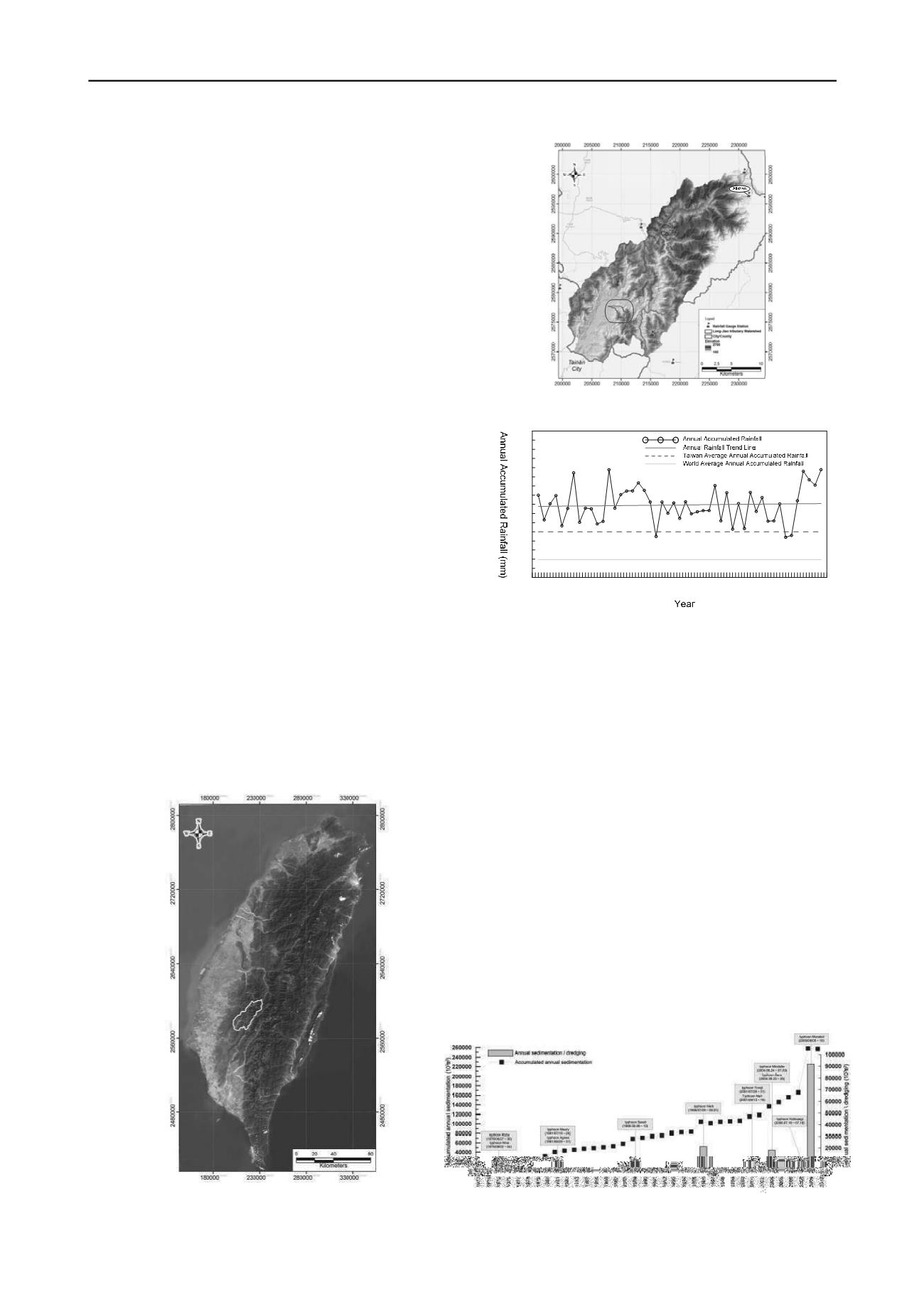
572
Proceedings of the 18
th
International Conference on Soil Mechanics and Geotechnical Engineering, Paris 2013
2 OVERVIEW OF ENVIRONMENT
2.1 Study area
As illustrated in Figure 1, the Tsengwen reservoir is located in
the southwestern portion of Taiwan. It is the most important
water resource conservation hydraulic structure and the largest
dam in Taiwan. The dam is 400 m in width and 133 m in height,
and mainly serves irrigation, municipal water and power supply
functions for the southern plains and downstream area of Chiayi
county, Tainan and Kaohsiung city shown in Figure 2. The
watershed area of Tsengwen Reservoir is approximately 481
km
2
, where Tsengwen river is the trunk river originating from
Alishan mountain at elevation of 2,609 m a.s.l. The watershed
shape is similar to a quadrilateral with elevations gradually
increasing from southwest to northeast, and ranging from 100 m
a.s.l and 2,700 m a.s.l. In general, most hill slopes are steeper
than 28.8
°
and approximately represents over 60% of the study
area. As for the aspect, slopes are mostly west-facing and
southwest-facing in the watershed. There are many fault line
and geologic structures and the geological condition of the
watershed consists mostly of sandy shale, siltstone, and isolated
areas of muddy sandstone, which are prone to more severe
weathering and become weak layers in the rock strata. These
conditions make the slope unstable during heavy rainfall or
strong earthquake shaking. Hence, during the typhoon and flood
season, the combination of huge rainfalls and local weak
geological conditions easily permit the occurrence of sediment
landslides (Lo
et al
., 2012).
Due to high topographic relief, annual average temperature
ranges from 24
℃
in the plains and 11
℃
in the mountainous
parts of the watershed. According to Alishan rainfall gauge
station, average annual accumulated ranges from 1,950 to 4,980
㎜
. Recent extreme rainfalls have caused annual accumulated
rainfall of Taiwan to increase, especially for Alishan, where,
since 2005, annual rainfalls have exceeded 5,000
㎜
(see Figure
3). This rate is double the annual average precipitation (2,500
㎜
) for Taiwan and over four times of world annual average
precipitation. Rainfall distribution increases from the plains to
the mountains and is mostly concentrated between May and
September when the watershed receives approximately 80% of
the overall annual rainfall.
Figure 1. Graphical location of Tsengwen reservoir watershed in
Taiwan (local coordinate system: TWD97).
Figure 2. Topographic map of Tsengwen reservoir watershed (local
coordinate system: TWD97).
1959
1960
1961
1962
1963
1964
1965
1966
1967
1968
1969
1970
1971
1972
1973
1974
1975
1976
1977
1978
1979
1980
1981
1982
1983
1984
1985
1986
1987
1988
1989
1990
1991
1992
1993
1994
1995
1996
1997
1998
1999
2000
2001
2002
2003
2004
2005
2006
2007
2008
2009
0
1000
2000
3000
4000
5000
6000
7000
8000
Gr
Figure 3. Time series of annual rainfalls at Alishan gauge station.
2.2 Relation between reservoir sedimentation and major
typhoon events
Presently, the greatest challenge of Tsengwen reservoir is
sedimentation. Whether caused by anthropogenic or natural
factors, both of them directly triggers problems such as
increased turbidity and reduced reservoir storage volume.
Figure 4 illustrates the historical trends of sedimentation in
Tsengwen reservoir concerning major typhoon events.
According to the figure, since completion of reservoir
construction, typhoons repeatedly hit the Tsengwen reservoir. It
can be found that the peaks in the historical sedimentation curve
of Tsengwen reservoir correspond to major typhoon events.
Before 2008, the annual average sedimentation volume is
4,760,000 m
3
and still lower than the yearly designed value of
5610,000 m
3
. However, 2009 typhoon Morakot brought around
91,080,000 m
3
of sediment into Tsengwen Reservoir, which
occupies about 12% of the reservoir capacity. After the 2009
typhoon Morakot, the annual average sedimentation rapidly
increases to 7,060,000 m
3
, exceeding the yearly designed value
by 12.6 times. It is truly believed that massive amounts of
sediment washed downstream. Also, this event seriously
resulted in debris flows and large large-scale landsides along
river flanks and close to human inhabitation in upstream areas,
and threatens longevity of reservoir and significantly affects
water supply to the south area in Taiwan.
Figure 4. Historical sedimentation curve of Tsengwen reservoir with the
major typhoon events


